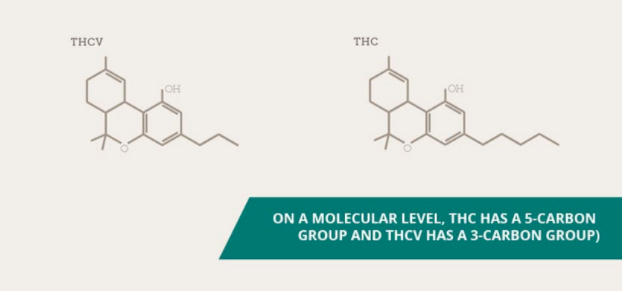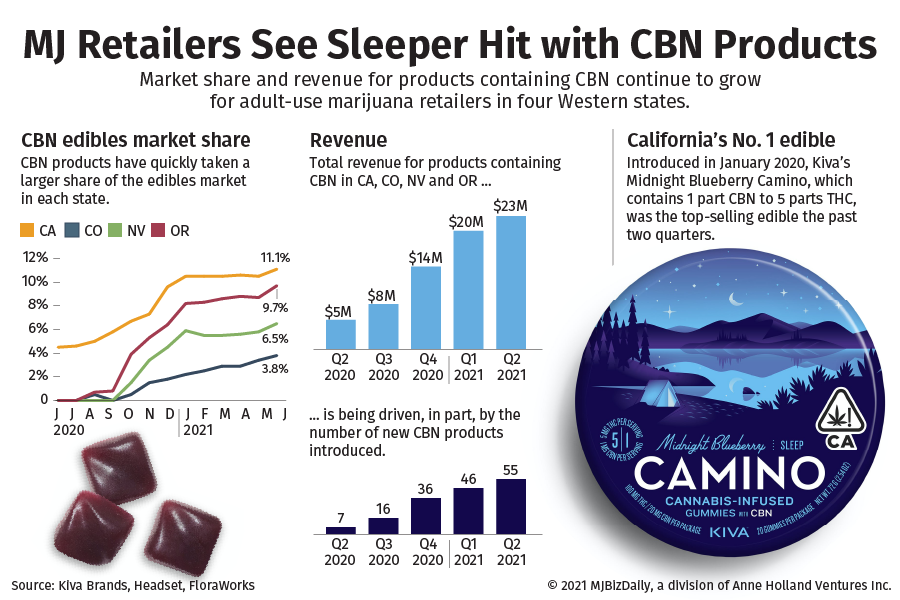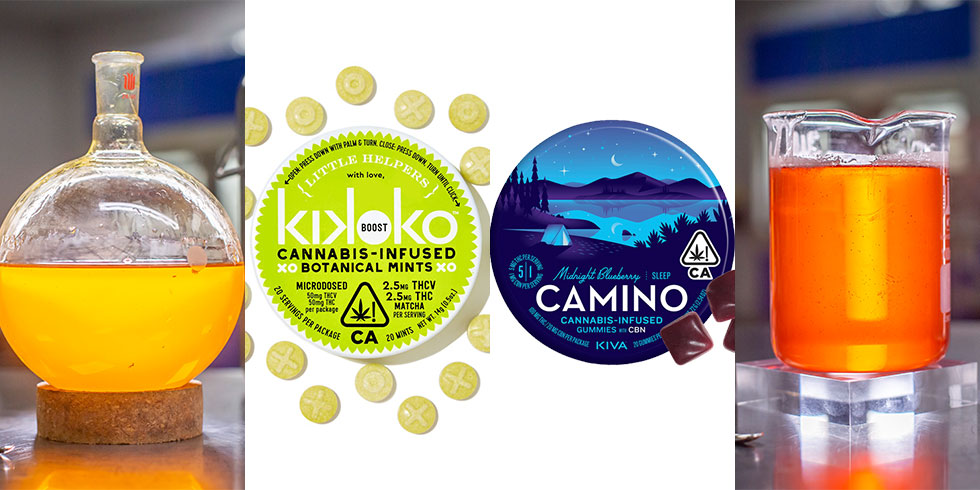Author: Nicole Brown
September 8, 2021 – 10 min read
2021 has the potential to be remembered as the year when minor cannabinoids achieved major status. While it’s true that the cannabis market is generally interested in tetrahydrocannabinol (THC), the intoxicating cannabinoid that most marijuana consumers have come to know and love; as well as cannabidiol (CBD); but cannabinoids such as tetrahydrocannabivarin (THCV) cannabinol (CBN) have started to attract attention on their own.
THCV: The Sports Car of Cannabinoids
THCV is probably the most sought-after cannabinoid on earth. Industry people refer to THCV as “the sports car of cannabinoids,” “diet weed,” or “skinny pot,” terms that allude to its effects and rarity. More than a decade ago, investigation on THCV was spearheaded by GW Pharmaceuticals who wanted to research its therapeutic potential in metabolic disorders and weight loss. Metabolic issues can cause high blood pressure, blood sugar imbalances, increased abdominal fat, and high or low cholesterol.
Since then, animal studies have found that THCV may decrease fat in the liver, balance insulin, reduce hunger cravings, improve bladder control, and have therapeutic potential for schizophrenia, Parkinson’s, epilepsy, and nausea reduction. In human trials, THCV has been found to change elements of brain functioning related to food intake and improve blood sugar control for participants with type 2 diabetes. In laboratory studies, THCV has shown promise in decreasing inflammation, pain, liver damage, and may be useful as an anti-acne agent.
In 2017, Vice news followed Franco Loja and Arjan Roskam, the founders of the famous Green House Seed Company, into the Democratic Republic of the Congo as they looked for rare plants that might produce THCV. A grueling journey brought back a strain that tested at only 1.1 percent THCV—a fairly tiny amount, but enough for Roskam to say that it was “worth the effort, going into the jungle, fighting your way through, bribing your way through, in the end you have the reward.” Loja later died after contracting malaria on a subsequent trip in January 2017.
What about THCV could entice someone to risk death to hunt for it? THCV has been shown to be energizing and appetite suppressing, two traits that make it an obvious candidate for a valuable form of cannabis. Who in America doesn’t want to lose weight and get more energy from an herbal drug?
What is THCV?
Tetrahydrocannabivarin (THCV) is a minor cannabinoid that naturally occurs in hemp plants. Although THCV isolate is similar in name to THC (the compound that is responsible for marijuana’s mind-altering effects), the two compounds are actually quite different. On a molecular level, THC and THCV are actually quite similar but have one distinct difference – the number of carbon atoms that make up their composition. THC has a pentyl (5-carbon) side-chain, and THCV has a propyl (3-carbon) side chain.

This is significant, as the slight variances between THC and THCV cause them each to have different effects. One of the most interesting differences between the two compounds is their effect on appetite. THC is known to increase the desire to eat, while THCV does the opposite. And with its potential ability to suppress appetite, THCV is gaining a reputation as an aid to losing weight.
THCV Method Development & Commercialization
Thanks to scientific breakthroughs in processing techniques, a few processors have learned how to isolate THCV with almost no product impurities. By using THCV Isolate as an ingredient, you can standardize your formulating methods to get precise amounts of THCV into your finished cannabinoid products.
In early 2020, OBX began our pursuit of THCV production. Over the course of many months, OBX developed and refined methods of development. resulting in THCV isolate that is consistently greater than 99% purity, at commercial scale. As we began to introduce our THCV to the market, our 3rd party external laboratory partners reached out to us, as none of the current laboratories had a reference standard for pure THCV, and therefore were unable to test the material and provide a certificate of analysis. The OBX technical team worked closely with each lab, to help them read the chromatography results, and ultimately create a reference standard that could be used for THCV going forward.
The development and commercialization of THCV, an ingredient so novel and rare that no reference standard of testing existed before OBX produced the material to create the standard — that is the definition of being at the vanguard of ingredient innovation.
What Science Says About THCV
Like most cannabinoids, THCV did not become a research focus until very recently. As of today, research findings on THCV are relatively limited. Nonetheless, these few studies have produced extremely positive results and have helped fast-track THCV to phase 2 of FDA clinical trials.(1) While researchers continue to unearth new information, THCV has demonstrated a potential for the following:
- Appetite Suppressant: Evidence suggests that, at low doses ranging between 5 and 7.5 milligrams, THCV inhibits appetite by antagonizing the CB1 receptors. A 2015 study found that the effect of it on the CB1 receptors suggested a potential to treating obesity. According to Kurek, the findings of this study suggest that THCV could provide treatment without the risk of side effects found in common anti-obesity drugs, such as depression, anxiety, and insomnia.
- Diabetes: In a 2016 study published in Diabetes Care, researchers found that CBD and THCV appeared to help patients with type 2 diabetes maintain tighter glycemic control, which is essential in preventing chronic complications from the condition. Research has also shown that, at moderate to high doses ranging between 10 and 20 milligrams, THCV regulated blood sugar levels and reduced the body’s resistance to insulin.
- Epilepsy: THCV has also been researched for its anti-epileptic properties, suggesting that it could also be used to reduce seizures for epileptic patients. In a 2015 study published in the Journal of Clinical Pharmacy and Therapeutics, researchers found that THCV showcased anticonvulsant effects, significantly reducing seizure incidences in an in vitro model induced with epileptic activity.
- Parkinson’s Disease: In a 2011 study on lab mice, researchers found that THCV held antioxidant properties that could prove useful in treating the symptoms and delaying neurodegeneration in Parkinson’s disease.
- Schizophrenia: In a 2015 study published in the British Journal of Pharmacology, researchers found that this particular cannabinoid enhanced serotonin receptors and demonstrated antipsychotic effects in lab rats, leading the authors to conclude that THCV could provide “therapeutic potential for ameliorating some of the negative, cognitive, and positive symptoms of schizophrenia.”
THCV Products We Love
As consumer awareness and demand for THCV continues to grow, we are starting to see more and more brands incorporating THCV into their products, and even entire product lines focused on THCV.
- Based in Hawaii, Rare Cannabinoid Co. leads the rare and minor cannabinoid industry as the first to offer tinctures as well as single extracts of THCV.
- Temper offers a first of its kind enhanced daily THCV supplement optimized to support intermittent fasting and block hunger pains for longer, healthier lives.
- Kikoko’s Little Helpers Boost Mints combine 2.5mg THCV with 2.5mg THC, along with Yuzu, Coconut, Matcha, Turmeric, and Black Pepper for a motivating feeling that boosts energy, suppresses appetite, and relieves pain.
- Liweli’s In The Zone Mints promote alertness and reduce situational stress with quick-dissolving tablets combining 5mg THCV with 2.5mg CBC.
CBN: The Sleeping Giant
Cannabinol (CBN) has officially earned its position as the sleeping giant of the cannabinoid industry — and demand is climbing. Despite some of the new hype, CBN was the first cannabinoid to ever be identified when British scientists isolated it from hemp resin in 1896.(1) Ironically, hemp plants do not actually produce CBN themselves, but only the compounds that break down into CBN over time. So while fresh hemp does not contain much CBN, you can attain more of CBN by simply allowing the plant material to age.(2) According to recent research, there are plenty of reasons why you might want to do that.
What Science Says About CBN
CBN isolate has presented itself as one of the most exciting rare cannabinoid ingredients because of its many potential therapeutic effects. While there is still research to be done, the initial research shows that cannabinol has the following characteristics:
- Antibacterial Properties of CBN: CBN has been shown to have powerful antibacterial properties. CBN demonstrates potent activity against MRSA, a dangerous type of antibiotic-resistant bacteria.(3) Earlier this year, one study even found that CBN was better at reducing the kind of dental bacteria that causes cavities, bad breath, and tooth decay than Oral B or Colgate toothpaste.(4)
- Anti-Cancer Properties of CBN: While many cannabinoids are being considered for anti-cancer therapies, CBN seems to be particularly effective.(5) For example, one study found that CBN was able to significantly reduce tumor size and increase the lifespan of mice with lung cancer, while CBD did neither.(6)
- Neuroprotective Properties of CBN: CBN is also being investigated as a possible neuroprotective. In one study, CBN supplementation significantly delayed the onset of adult-onset neurodegenerative disease in mice. This suggests that it might be useful in treating ALS, the most common adult-onset motor neuron disorder in humans.(7)
- Physically Restorative Properties of CBN: In addition to possibly treating the life-threatening conditions listed above, CBN may also be extremely useful in managing everyday ailments and injuries. Studies suggest that CBN may do wonders for pain, and structural damage.
CBN for Sleep
Despite all of the great wellness benefits described above, CBN is marketed almost exclusively as a sleep aid. While there is plenty of anecdotal evidence to back up this use case, and even early indicators in our research lab that CBN may support sleep, the published and democratized scientific research supporting this potential use case is limited.
- Many of the claims about CBN’s sedative effects can be traced back to a study from 1975. In this study, five male volunteers reported that while a combination of CBN and THC made them feel “drugged, drunk, dizzy, and drowsy.”(11)
- In that same study, CBN supplementation alone produced no effects on volunteers.(12) Yet, some believe that the sedative properties of CBN might be promoted with the presence of other cannabinoids and terpenes in formulations.
CBN Upcoming Research
While at this point there is still limited scientific evidence supporting the sleep-inducing properties of CBN, we plan to rigorously study this cannabinoid in our labs to uncover its full therapeutic potential. OBX is proud to support CBN studies around the world with our pure CBN ingredient, including the recently announced study with Charlotte’s Web and the University of Colorado Boulder’s REACH (Research and Education Addressing Cannabis and Health) Center. This preclinical study will inform future clinical initiatives to better understand how specific ratios of cannabinoids and different delivery formats are effective at supporting improved sleep quality and instilling healthier sleep architecture in humans.
CBN Commercial Trends
Over the past year, cannabis companies have been leveraging the CBN’s reputation as a sleep aid with growing success. According to a recent study published by Hemp Industry Daily, sales of products containing CBN – almost entirely edibles, at this point – totaled more than $65 million in the past four quarters for adult-use retailers in California, Colorado, Nevada, and Oregon. There were only seven CBN products in those combined states a year ago, but that number grew to 55 in the second quarter of 2021, up 20% from the first three months of the year.

In California alone, CBN products provided $16.1 million in sales for the second quarter of this year in the state, up 6.6% from the previous quarter and 120% from the third quarter of 2020.
CBN edibles are taking a larger share of that market. Edibles containing the cannabinoid accounted for 11% of California edible sales in June, up 6.5 percentage points from 2020, and this trend has carried through in other states. Sales of CBN edibles in Oregon, Nevada, and Colorado were almost nonexistent in June and July 2020, but they ended June 2021 at 9.7%, 6.5%, and 3.8%, respectively, as a percentage of each state’s edibles market.

California-based edibles company Kiva Brands, an early CBN adopter, is riding the wave of early growth. Introduced in January 2020, Kiva Brands’ Camino Midnight Blueberry gummies, which contain 1 part CBN to 5 parts THC, have been the top-selling edible in California for the past two quarters.
Some believe CBN’s sedative effects can be amplified when paired with THC. Many of the regulated CBN products contain this hybrid or ratio model, providing a small portion of CBN paired with some amount of THC – such as Camino’s 5-to-1 proportion.
Kristi Palmer, Kiva’s co-founder and head of business development, said the company came upon this formulation after lots of research and testing, which showed the beneficial effect involving this particular ratio. “We’re doing as much research as we can on the back end to make sure it’s the right path to go down,” she said. “You use a lot of data to make those decisions, but there’s nothing quite like seeing the sales and seeing the traction take place.”
CBN Products We Love
As consumer demand for CBN products continues to grow, we’ve seen an exponential increase in products containing the powerful ingredient —
- Tinctures: Dosist’s THC-Free Collection includes their Sleep Dose Drop, containing a 5:1 CBD:CBN ratio formula designed to help you fall asleep and stay asleep naturally, with 900mg of cannabinoid content per bottle and 15mg per dose, and Green Roads Sweet Sleep Oil provides 25mg combined of CBD and CBN.
- Gummies: With its potential benefits for sleep and relaxation, CBN is a sought-after ingredient for gummies. A few of the most popular gummy products featuring CBN are Incredibles’ Snoozzzeberry gummies, with 10mg THC and 2mg CBN per piece, Kiva Confections’ Camino Midnight Blueberry gummies, pairing relaxing terpenes with a hint of chamomile and lavender along with 5mg of THC and 1mg of CBN to support a more restful night’s sleep, and Wyld’s Elderberry Gummies, with 25mg CBD and 5mg CBN per gummy.
The Future of THCV and CBN
Like many of the other cannabinoids, there is still a great deal to be discovered and understood about the therapeutic potential of THCV and CBN. As research institutions continue to garner the resources to organize and publish clinical trials and rare cannabinoid processors begin to yield consistent purity and scale in the production of these powerful cannabinoids, we believe there is a great deal of potential for THCV and CBN to be the leading rare cannabinoids to transform health and wellness.
As the scientific evidence behind THCV and CBN continues to develop, the market is ripe for a plethora of new products. With consumer awareness and acceptance of the therapeutic benefits to be gained from cannabis at an all-time high, there has never been a better time for product formulators and manufacturers to start working with rare cannabinoid ingredients like THCV and CBN.
To learn more about THCV and CBN, how OBX can support your product development initiatives, or how we can collaborate, please reach out to us at info@openbookextracs.com.
References
1) Wood, Spivey and Easterfield. “Cannabinol:”J. Chem. Soc., 20 (1899).
2) Russo EB, Marcu J. Cannabis Pharmacology: The Usual Suspects and a Few Promising Leads. Adv Pharmacol. 2017;80:67-134. doi:10.1016/bs.apha.2017.03.004
3) Appendino G, Gibbons S, Giana A, et al. Antibacterial cannabinoids from Cannabis sativa: a structure-activity study. J Nat Prod. 2008;71(8):1427-1430. doi:10.1021/np8002673
4) Stahl, Veronica, and Kumar Vasudevan. “Comparison of Efficacy of Cannabinoids versus Commercial Oral Care Products in Reducing Bacterial Content from Dental Plaque: A Preliminary Observation.” Cureus vol. 12,1 e6809. 29 Jan. 2020, doi:10.7759/cureus.6809
5) Dariš, Barbara et al. “Cannabinoids in cancer treatment: Therapeutic potential and legislation.” Bosnian journal of basic medical sciences vol. 19,1 14-23. 12 Feb. 2019, doi:10.17305/bjbms.2018.3532
6) Munson AE, Harris LS, Friedman MA, Dewey WL, Carchman RA. Antineoplastic activity of cannabinoids. J Natl Cancer Inst. 1975;55(3):597-602. doi:10.1093/jnci/55.3.597
7) Weydt, Patrick et al. “Cannabinol delays symptom onset in SOD1 (G93A) transgenic mice without affecting survival.” Amyotrophic lateral sclerosis and other motor neuron disorders : official publication of the World Federation of Neurology, Research Group on Motor Neuron Diseases vol. 6,3 (2005): 182-4. doi:10.1080/14660820510030149
8) Wong H, Cairns BE. Cannabidiol, cannabinol and their combinations act as peripheral analgesics in a rat model of myofascial pain. Arch Oral Biol. 2019;104:33-39. doi:10.1016/j.archoralbio.2019.05.028
9) Wilkinson JD, Williamson EM. Cannabinoids inhibit human keratinocyte proliferation through a non-CB1/CB2 mechanism and have a potential therapeutic value in the treatment of psoriasis. J Dermatol Sci. 2007;45(2):87-92. doi:10.1016/j.jdermsci.2006.10.009
10) Scutt A, Williamson EM. Cannabinoids stimulate fibroblastic colony formation by bone marrow cells indirectly via CB2 receptors. Calcif Tissue Int. 2007;80(1):50-59. doi:10.1007/s00223-006-0171-7
11) Karniol, I G et al. “Effects of delta9-tetrahydrocannabinol and cannabinol in man.” Pharmacology vol. 13,6 (1975): 502-12. Doi
12) Ibid.
Author: Nicole Brown
September 8, 2021 – 10 min read
2021 has the potential to be remembered as the year when minor cannabinoids achieved major status. While it’s true that the cannabis market is generally interested in tetrahydrocannabinol (THC), the intoxicating cannabinoid that most marijuana consumers have come to know and love; as well as cannabidiol (CBD); but cannabinoids such as tetrahydrocannabivarin (THCV) cannabinol (CBN) have started to attract attention on their own.
THCV: The Sports Car of Cannabinoids
THCV is probably the most sought-after cannabinoid on earth. Industry people refer to THCV as “the sports car of cannabinoids,” “diet weed,” or “skinny pot,” terms that allude to its effects and rarity. More than a decade ago, investigation on THCV was spearheaded by GW Pharmaceuticals who wanted to research its therapeutic potential in metabolic disorders and weight loss. Metabolic issues can cause high blood pressure, blood sugar imbalances, increased abdominal fat, and high or low cholesterol.
Since then, animal studies have found that THCV may decrease fat in the liver, balance insulin, reduce hunger cravings, improve bladder control, and have therapeutic potential for schizophrenia, Parkinson’s, epilepsy, and nausea reduction. In human trials, THCV has been found to change elements of brain functioning related to food intake and improve blood sugar control for participants with type 2 diabetes. In laboratory studies, THCV has shown promise in decreasing inflammation, pain, liver damage, and may be useful as an anti-acne agent.
In 2017, Vice news followed Franco Loja and Arjan Roskam, the founders of the famous Green House Seed Company, into the Democratic Republic of the Congo as they looked for rare plants that might produce THCV. A grueling journey brought back a strain that tested at only 1.1 percent THCV—a fairly tiny amount, but enough for Roskam to say that it was “worth the effort, going into the jungle, fighting your way through, bribing your way through, in the end you have the reward.” Loja later died after contracting malaria on a subsequent trip in January 2017.
What about THCV could entice someone to risk death to hunt for it? THCV has been shown to be energizing and appetite suppressing, two traits that make it an obvious candidate for a valuable form of cannabis. Who in America doesn’t want to lose weight and get more energy from an herbal drug?
What is THCV?
Tetrahydrocannabivarin (THCV) is a minor cannabinoid that naturally occurs in hemp plants. Although THCV isolate is similar in name to THC (the compound that is responsible for marijuana’s mind-altering effects), the two compounds are actually quite different. On a molecular level, THC and THCV are actually quite similar but have one distinct difference – the number of carbon atoms that make up their composition. THC has a pentyl (5-carbon) side-chain, and THCV has a propyl (3-carbon) side chain.

This is significant, as the slight variances between THC and THCV cause them each to have different effects. One of the most interesting differences between the two compounds is their effect on appetite. THC is known to increase the desire to eat, while THCV does the opposite. And with its potential ability to suppress appetite, THCV is gaining a reputation as an aid to losing weight.
THCV Method Development & Commercialization
Thanks to scientific breakthroughs in processing techniques, a few processors have learned how to isolate THCV with almost no product impurities. By using THCV Isolate as an ingredient, you can standardize your formulating methods to get precise amounts of THCV into your finished cannabinoid products.
In early 2020, OBX began our pursuit of THCV production. Over the course of many months, OBX developed and refined methods of development. resulting in THCV isolate that is consistently greater than 99% purity, at commercial scale. As we began to introduce our THCV to the market, our 3rd party external laboratory partners reached out to us, as none of the current laboratories had a reference standard for pure THCV, and therefore were unable to test the material and provide a certificate of analysis. The OBX technical team worked closely with each lab, to help them read the chromatography results, and ultimately create a reference standard that could be used for THCV going forward.
The development and commercialization of THCV, an ingredient so novel and rare that no reference standard of testing existed before OBX produced the material to create the standard — that is the definition of being at the vanguard of ingredient innovation.
What Science Says About THCV
Like most cannabinoids, THCV did not become a research focus until very recently. As of today, research findings on THCV are relatively limited. Nonetheless, these few studies have produced extremely positive results and have helped fast-track THCV to phase 2 of FDA clinical trials.(1) While researchers continue to unearth new information, THCV has demonstrated a potential for the following:
- Appetite Suppressant: Evidence suggests that, at low doses ranging between 5 and 7.5 milligrams, THCV inhibits appetite by antagonizing the CB1 receptors. A 2015 study found that the effect of it on the CB1 receptors suggested a potential to treating obesity. According to Kurek, the findings of this study suggest that THCV could provide treatment without the risk of side effects found in common anti-obesity drugs, such as depression, anxiety, and insomnia.
- Diabetes: In a 2016 study published in Diabetes Care, researchers found that CBD and THCV appeared to help patients with type 2 diabetes maintain tighter glycemic control, which is essential in preventing chronic complications from the condition. Research has also shown that, at moderate to high doses ranging between 10 and 20 milligrams, THCV regulated blood sugar levels and reduced the body’s resistance to insulin.
- Epilepsy: THCV has also been researched for its anti-epileptic properties, suggesting that it could also be used to reduce seizures for epileptic patients. In a 2015 study published in the Journal of Clinical Pharmacy and Therapeutics, researchers found that THCV showcased anticonvulsant effects, significantly reducing seizure incidences in an in vitro model induced with epileptic activity.
- Parkinson’s Disease: In a 2011 study on lab mice, researchers found that THCV held antioxidant properties that could prove useful in treating the symptoms and delaying neurodegeneration in Parkinson’s disease.
- Schizophrenia: In a 2015 study published in the British Journal of Pharmacology, researchers found that this particular cannabinoid enhanced serotonin receptors and demonstrated antipsychotic effects in lab rats, leading the authors to conclude that THCV could provide “therapeutic potential for ameliorating some of the negative, cognitive, and positive symptoms of schizophrenia.”
THCV Products We Love
As consumer awareness and demand for THCV continues to grow, we are starting to see more and more brands incorporating THCV into their products, and even entire product lines focused on THCV.
- Based in Hawaii, Rare Cannabinoid Co. leads the rare and minor cannabinoid industry as the first to offer tinctures as well as single extracts of THCV.
- Temper offers a first of its kind enhanced daily THCV supplement optimized to support intermittent fasting and block hunger pains for longer, healthier lives.
- Kikoko’s Little Helpers Boost Mints combine 2.5mg THCV with 2.5mg THC, along with Yuzu, Coconut, Matcha, Turmeric, and Black Pepper for a motivating feeling that boosts energy, suppresses appetite, and relieves pain.
- Liweli’s In The Zone Mints promote alertness and reduce situational stress with quick-dissolving tablets combining 5mg THCV with 2.5mg CBC.
CBN: The Sleeping Giant
Cannabinol (CBN) has officially earned its position as the sleeping giant of the cannabinoid industry — and demand is climbing. Despite some of the new hype, CBN was the first cannabinoid to ever be identified when British scientists isolated it from hemp resin in 1896.(1) Ironically, hemp plants do not actually produce CBN themselves, but only the compounds that break down into CBN over time. So while fresh hemp does not contain much CBN, you can attain more of CBN by simply allowing the plant material to age.(2) According to recent research, there are plenty of reasons why you might want to do that.
What Science Says About CBN
CBN isolate has presented itself as one of the most exciting rare cannabinoid ingredients because of its many potential therapeutic effects. While there is still research to be done, the initial research shows that cannabinol has the following characteristics:
- Antibacterial Properties of CBN: CBN has been shown to have powerful antibacterial properties. CBN demonstrates potent activity against MRSA, a dangerous type of antibiotic-resistant bacteria.(3) Earlier this year, one study even found that CBN was better at reducing the kind of dental bacteria that causes cavities, bad breath, and tooth decay than Oral B or Colgate toothpaste.(4)
- Anti-Cancer Properties of CBN: While many cannabinoids are being considered for anti-cancer therapies, CBN seems to be particularly effective.(5) For example, one study found that CBN was able to significantly reduce tumor size and increase the lifespan of mice with lung cancer, while CBD did neither.(6)
- Neuroprotective Properties of CBN: CBN is also being investigated as a possible neuroprotective. In one study, CBN supplementation significantly delayed the onset of adult-onset neurodegenerative disease in mice. This suggests that it might be useful in treating ALS, the most common adult-onset motor neuron disorder in humans.(7)
- Physically Restorative Properties of CBN: In addition to possibly treating the life-threatening conditions listed above, CBN may also be extremely useful in managing everyday ailments and injuries. Studies suggest that CBN may do wonders for pain, and structural damage.
CBN for Sleep
Despite all of the great wellness benefits described above, CBN is marketed almost exclusively as a sleep aid. While there is plenty of anecdotal evidence to back up this use case, and even early indicators in our research lab that CBN may support sleep, the published and democratized scientific research supporting this potential use case is limited.
- Many of the claims about CBN’s sedative effects can be traced back to a study from 1975. In this study, five male volunteers reported that while a combination of CBN and THC made them feel “drugged, drunk, dizzy, and drowsy.”(11)
- In that same study, CBN supplementation alone produced no effects on volunteers.(12) Yet, some believe that the sedative properties of CBN might be promoted with the presence of other cannabinoids and terpenes in formulations.
CBN Upcoming Research
While at this point there is still limited scientific evidence supporting the sleep-inducing properties of CBN, we plan to rigorously study this cannabinoid in our labs to uncover its full therapeutic potential. OBX is proud to support CBN studies around the world with our pure CBN ingredient, including the recently announced study with Charlotte’s Web and the University of Colorado Boulder’s REACH (Research and Education Addressing Cannabis and Health) Center. This preclinical study will inform future clinical initiatives to better understand how specific ratios of cannabinoids and different delivery formats are effective at supporting improved sleep quality and instilling healthier sleep architecture in humans.
CBN Commercial Trends
Over the past year, cannabis companies have been leveraging the CBN’s reputation as a sleep aid with growing success. According to a recent study published by Hemp Industry Daily, sales of products containing CBN – almost entirely edibles, at this point – totaled more than $65 million in the past four quarters for adult-use retailers in California, Colorado, Nevada, and Oregon. There were only seven CBN products in those combined states a year ago, but that number grew to 55 in the second quarter of 2021, up 20% from the first three months of the year.

In California alone, CBN products provided $16.1 million in sales for the second quarter of this year in the state, up 6.6% from the previous quarter and 120% from the third quarter of 2020.
CBN edibles are taking a larger share of that market. Edibles containing the cannabinoid accounted for 11% of California edible sales in June, up 6.5 percentage points from 2020, and this trend has carried through in other states. Sales of CBN edibles in Oregon, Nevada, and Colorado were almost nonexistent in June and July 2020, but they ended June 2021 at 9.7%, 6.5%, and 3.8%, respectively, as a percentage of each state’s edibles market.

California-based edibles company Kiva Brands, an early CBN adopter, is riding the wave of early growth. Introduced in January 2020, Kiva Brands’ Camino Midnight Blueberry gummies, which contain 1 part CBN to 5 parts THC, have been the top-selling edible in California for the past two quarters.
Some believe CBN’s sedative effects can be amplified when paired with THC. Many of the regulated CBN products contain this hybrid or ratio model, providing a small portion of CBN paired with some amount of THC – such as Camino’s 5-to-1 proportion.
Kristi Palmer, Kiva’s co-founder and head of business development, said the company came upon this formulation after lots of research and testing, which showed the beneficial effect involving this particular ratio. “We’re doing as much research as we can on the back end to make sure it’s the right path to go down,” she said. “You use a lot of data to make those decisions, but there’s nothing quite like seeing the sales and seeing the traction take place.”
CBN Products We Love
As consumer demand for CBN products continues to grow, we’ve seen an exponential increase in products containing the powerful ingredient —
- Tinctures: Dosist’s THC-Free Collection includes their Sleep Dose Drop, containing a 5:1 CBD:CBN ratio formula designed to help you fall asleep and stay asleep naturally, with 900mg of cannabinoid content per bottle and 15mg per dose, and Green Roads Sweet Sleep Oil provides 25mg combined of CBD and CBN.
- Gummies: With its potential benefits for sleep and relaxation, CBN is a sought-after ingredient for gummies. A few of the most popular gummy products featuring CBN are Incredibles’ Snoozzzeberry gummies, with 10mg THC and 2mg CBN per piece, Kiva Confections’ Camino Midnight Blueberry gummies, pairing relaxing terpenes with a hint of chamomile and lavender along with 5mg of THC and 1mg of CBN to support a more restful night’s sleep, and Wyld’s Elderberry Gummies, with 25mg CBD and 5mg CBN per gummy.
The Future of THCV and CBN
Like many of the other cannabinoids, there is still a great deal to be discovered and understood about the therapeutic potential of THCV and CBN. As research institutions continue to garner the resources to organize and publish clinical trials and rare cannabinoid processors begin to yield consistent purity and scale in the production of these powerful cannabinoids, we believe there is a great deal of potential for THCV and CBN to be the leading rare cannabinoids to transform health and wellness.
As the scientific evidence behind THCV and CBN continues to develop, the market is ripe for a plethora of new products. With consumer awareness and acceptance of the therapeutic benefits to be gained from cannabis at an all-time high, there has never been a better time for product formulators and manufacturers to start working with rare cannabinoid ingredients like THCV and CBN.
To learn more about THCV and CBN, how OBX can support your product development initiatives, or how we can collaborate, please reach out to us at info@openbookextracs.com.
References
1) Wood, Spivey and Easterfield. “Cannabinol:”J. Chem. Soc., 20 (1899).
2) Russo EB, Marcu J. Cannabis Pharmacology: The Usual Suspects and a Few Promising Leads. Adv Pharmacol. 2017;80:67-134. doi:10.1016/bs.apha.2017.03.004
3) Appendino G, Gibbons S, Giana A, et al. Antibacterial cannabinoids from Cannabis sativa: a structure-activity study. J Nat Prod. 2008;71(8):1427-1430. doi:10.1021/np8002673
4) Stahl, Veronica, and Kumar Vasudevan. “Comparison of Efficacy of Cannabinoids versus Commercial Oral Care Products in Reducing Bacterial Content from Dental Plaque: A Preliminary Observation.” Cureus vol. 12,1 e6809. 29 Jan. 2020, doi:10.7759/cureus.6809
5) Dariš, Barbara et al. “Cannabinoids in cancer treatment: Therapeutic potential and legislation.” Bosnian journal of basic medical sciences vol. 19,1 14-23. 12 Feb. 2019, doi:10.17305/bjbms.2018.3532
6) Munson AE, Harris LS, Friedman MA, Dewey WL, Carchman RA. Antineoplastic activity of cannabinoids. J Natl Cancer Inst. 1975;55(3):597-602. doi:10.1093/jnci/55.3.597
7) Weydt, Patrick et al. “Cannabinol delays symptom onset in SOD1 (G93A) transgenic mice without affecting survival.” Amyotrophic lateral sclerosis and other motor neuron disorders : official publication of the World Federation of Neurology, Research Group on Motor Neuron Diseases vol. 6,3 (2005): 182-4. doi:10.1080/14660820510030149
8) Wong H, Cairns BE. Cannabidiol, cannabinol and their combinations act as peripheral analgesics in a rat model of myofascial pain. Arch Oral Biol. 2019;104:33-39. doi:10.1016/j.archoralbio.2019.05.028
9) Wilkinson JD, Williamson EM. Cannabinoids inhibit human keratinocyte proliferation through a non-CB1/CB2 mechanism and have a potential therapeutic value in the treatment of psoriasis. J Dermatol Sci. 2007;45(2):87-92. doi:10.1016/j.jdermsci.2006.10.009
10) Scutt A, Williamson EM. Cannabinoids stimulate fibroblastic colony formation by bone marrow cells indirectly via CB2 receptors. Calcif Tissue Int. 2007;80(1):50-59. doi:10.1007/s00223-006-0171-7
11) Karniol, I G et al. “Effects of delta9-tetrahydrocannabinol and cannabinol in man.” Pharmacology vol. 13,6 (1975): 502-12. Doi
12) Ibid.




